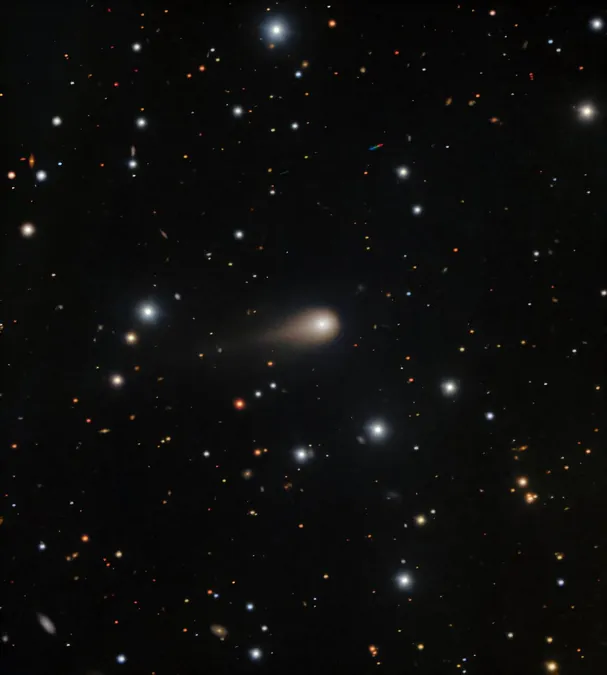
Astronomers Unveil Stunning Images and Insight from Comet 3I/ATLAS
2025-09-05
Author: Ming
A Celestial Marvel: Interstellar Comet 3I/ATLAS
Astronomers and students have collaborated on a groundbreaking educational initiative, capturing breathtaking new images of the ever-growing tail of interstellar Comet 3I/ATLAS. This rare celestial phenomenon not only showcases a vibrant tail and luminous coma but also provides crucial scientific insights into its composition and colors.
An Observational Breakthrough from Chile
On August 27, 2025, researchers harnessed the power of the Gemini Multi-Object Spectrograph (GMOS) at Gemini South, located in Chile, to obtain detailed multi-color images of 3I/ATLAS. This observatory is run by NSF NOIRLab, a key player in global astronomical research.
Engaging the Public: A Unique Learning Experience
The observations were part of a public outreach program by NSF NOIRLab, in partnership with 'Shadow the Scientists'—an initiative designed to connect the public with scientists for real-life astronomical experiences. Renowned astronomer Karen Meech from the University of Hawai'i Institute for Astronomy led this exciting endeavor.
In a thrilling two-hour Zoom session, participants—including students from Hawai'i and La Serena, Chile—had the unique opportunity to join the Gemini South control room remotely. They interacted with astronomers, asked questions about comet science, and witnessed the observation process live.
Spectacular Discoveries: A Closer Look at the Comet's Tail
The images captured during the session revealed a broad coma—a cloud of gas and dust surrounding the comet's icy core—as well as an impressive tail extending approximately 1/120th of a degree in the sky. This tail is significantly more pronounced than in previous observations, indicating increased activity from the comet as it journeys through the inner solar system.
Unlocking the Secrets of the Universe
The primary scientific goal of this observation was to collect the comet's spectrum—a key to understanding its chemistry and composition. Such data not only enhances our knowledge of 3I/ATLAS but also sheds light on the formation of planetary systems around distant stars.
First spotted on July 1, 2025, 3I/ATLAS is only the third confirmed interstellar comet, following 1I/'Oumuamua in 2017 and 2I/Borisov in 2019. Unlike solar-bound comets, 3I/ATLAS travels on a hyperbolic path that will ultimately take it back to interstellar space, offering astronomers a unique glimpse into the materials that shaped a distant star.
An Inspiration for Future Generations
During the session, Bin Yang, an assistant professor at Universidad Diego Portales, assisted participants in interpreting the spectral data, while Meech emphasized the significance of interstellar objects in understanding planetary system evolution.
"The observations revealed changes in the dust particles and allowed us to glimpse the comet's chemistry for the first time, which is incredibly exciting," Meech remarked.
The Impact of Interstellar Visitors
Bryce Bolin, a research scientist from Eureka Scientific, highlighted the importance of these observations, stating that each interstellar comet acts as a messenger from another star system, helping us decipher the diversity of worlds beyond our own.
Looking Ahead: A Follow-Up Session in November
As Comet 3I/ATLAS continues its journey, it will reappear from behind the sun in November 2025. At that time, Bolin will host another public observing session, bringing eager participants into the control room of the Gemini North telescope in Hawai'i.
"As 3I/ATLAS speeds back into the depths of interstellar space, we are reminded that our solar system is just one small part of a vast galaxy," Meech concluded. "These cosmic visitors may be fleeting, but their impact is profound and lasting."





 Brasil (PT)
Brasil (PT)
 Canada (EN)
Canada (EN)
 Chile (ES)
Chile (ES)
 Česko (CS)
Česko (CS)
 대한민국 (KO)
대한민국 (KO)
 España (ES)
España (ES)
 France (FR)
France (FR)
 Hong Kong (EN)
Hong Kong (EN)
 Italia (IT)
Italia (IT)
 日本 (JA)
日本 (JA)
 Magyarország (HU)
Magyarország (HU)
 Norge (NO)
Norge (NO)
 Polska (PL)
Polska (PL)
 Schweiz (DE)
Schweiz (DE)
 Singapore (EN)
Singapore (EN)
 Sverige (SV)
Sverige (SV)
 Suomi (FI)
Suomi (FI)
 Türkiye (TR)
Türkiye (TR)
 الإمارات العربية المتحدة (AR)
الإمارات العربية المتحدة (AR)